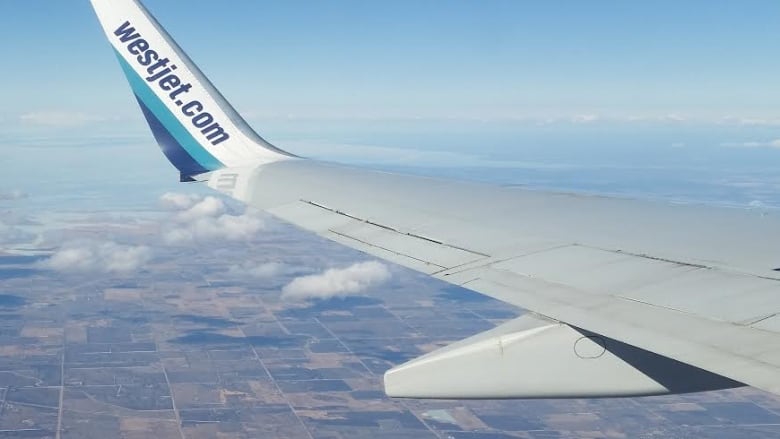WestJet and the leap into no-frills flying
The message for passengers? You're on a plane flying somewhere, so be happy that's it, says tourism expert

A flight on an ultra-low-cost carrier can be a trying experience.
There's the limited leg-room, of course, and ULCCs, as they are called in the business, have an almost magical ability to "unbundle"the trip.
Passengers pay extra for food and luggage;we're all used to that. There's a fee for carry-on baggage as well, in most cases. You want to get on early, so that you can stow that bag in the overhead compartment? There's a fee for that. Can't print your boarding pass at home. That'll cost you. The innovation is limitless. Uzbekistan Airways and Samoan Air charge passengers by weight. Just saying.
We put you in a plane and we fly you from Ireland to Eastern Europe, or something like that. Be happy, that's all we're doing for you.- Frederic Dimanche, Ryerson University
Most Canadians have flirted with ULCCs in Europe or the U.S., or even here in Canada with NewLeaf in the past year, but the no-frills airline is going mainstream now with WestJet's entry into the market.
Pending an agreement with its pilots (which just got trickierbecause of an upcoming unionization vote)the airline's plan is to take 10of its existingBoeing 737s, paint them, addmore seats, hire a cheaper crew, and get in the air with low prices and no-frills service. It hasn't said where it will fly, but has hinted that the U.S. is in its sights.
- WestJet to launch 'ultra-low-cost' no-frills carrier
- WestJet's pilots go for another unionization vote
It seems obvious that Canadians are keen for lower fares and will probably put up with at least some additional misery. But are there enough people and places to go to sustain another airline?
WestJet defends its turf
WestJet's move may have come as a surprise to employees, analysts and Canadians at large, but it makes moresense when you look at how the aviation market has developed in the past decade, particularly with the entry of NewLeaf last summer, and the expected entry (now questionable) of two other ULCCs.
NewLeaf stumbled out of the gate, having to delay its launch and then cancel destinations as WestJet targeted its routes. The head of NewLeaf said at the time that it was a case of the big guy trying to squash the little guy.
"WestJet realizes that the proposed low-cost carriers in the market were primarily targeting WestJet's core domestic routes," said Fred Lazar, an associate professor at York University who follows the aviation business.
"They decided they might as well just go head to head with NewLeaf and try to stop any new entrants."
WestJet couldn't do that with its existing cost structure, which, according to research done by the investment firm Raymond James,is much lower than Air Canada's, but much higher than Ryanair's.
Passengers both love and hate ULCCs
There's not much question that ULCCs are a success particularly in Europe.
Passengers seem to love and hate them in equal measure.
Ryanaircarries more passengers than any other airline in Europe. It and EasyJet dominate inter-city travel in Europe, increasingly pushing the legacy carriers like British Airways to the long-haul market.
This comesdespite the fact that the travel can be miserable.
"If you look at the rankings of airlines, the ULCCs always come in at the bottom," said Lazar. "The quality of service on the ULCCs makes United look like the premier airline in the world, and their service really sucks."
- Who wants pizza?': WestJet pilot buys food for stranded Air Canada passengers
- WestJet and London: A mess or a success?
Ryanairin particular doesn't apologize for its service, said FredericDimanche, professor at Ryerson University'sSchool of Hospitality andTourism Management.
"We put you in a plane and fly you from Ireland to Eastern Europe, or something like that. Be happy, that's all we're doing for you."
However, Dimanche isn't totally convinced the formulawill work here.
"They have a much bigger market to work with," he said. "Europe has lots of destinations and lots of populationthat they can draw to their flights. It remains to be seen within Canada if the market is large enough for an ultra-low-cost carrier."
Bay Street unconvinced
The market was not totally convinced, judging byWestJet'sshare reaction on Thursday when the airline announced plans to launch anULCCby the end of the year.
Its shares dropped on a day when the broader market was higher and Air Canada's stock barely budged.
In a research report, Ben Cherniavskyof Raymond Jamessaid he views WestJet's decision to launch a ULCC as a defensive move. But he's not sure the tactic will work, in part because of themixed history of having an "airline within an airline."
- 'It just doesn't work for us': WestJet on new YYC international terminal
- WestJet at 20: Grown-up airline, grown-up problems
Cherniavsky wrote that, "the problem with the model is that usually any cost savings related to denser seats anda cheaper crew (which is usually the extent of the savings) is offset by yield cannibalization, increased complexity and brand confusion."
In other words, WestJet will be competing with itselfwith the new airline.
However, Lazar thinks that it had no choice. "It's better that you cannibalize your market thanlet a competitor do it."












_(720p).jpg)


 OFFICIAL HD MUSIC VIDEO.jpg)
.jpg)



























































































